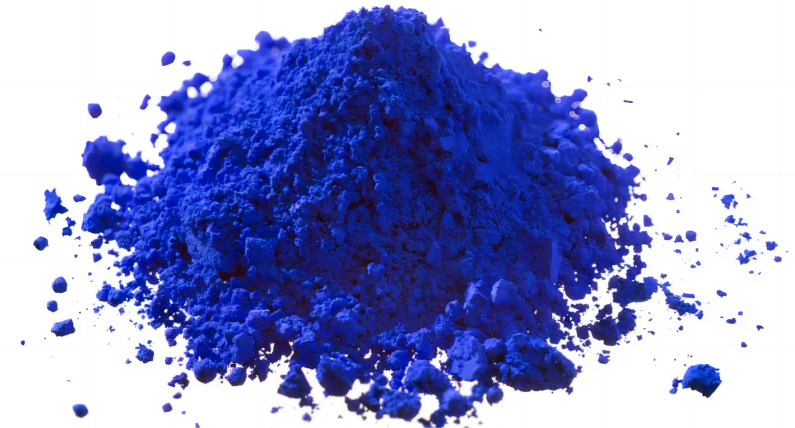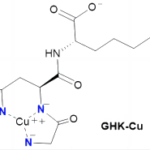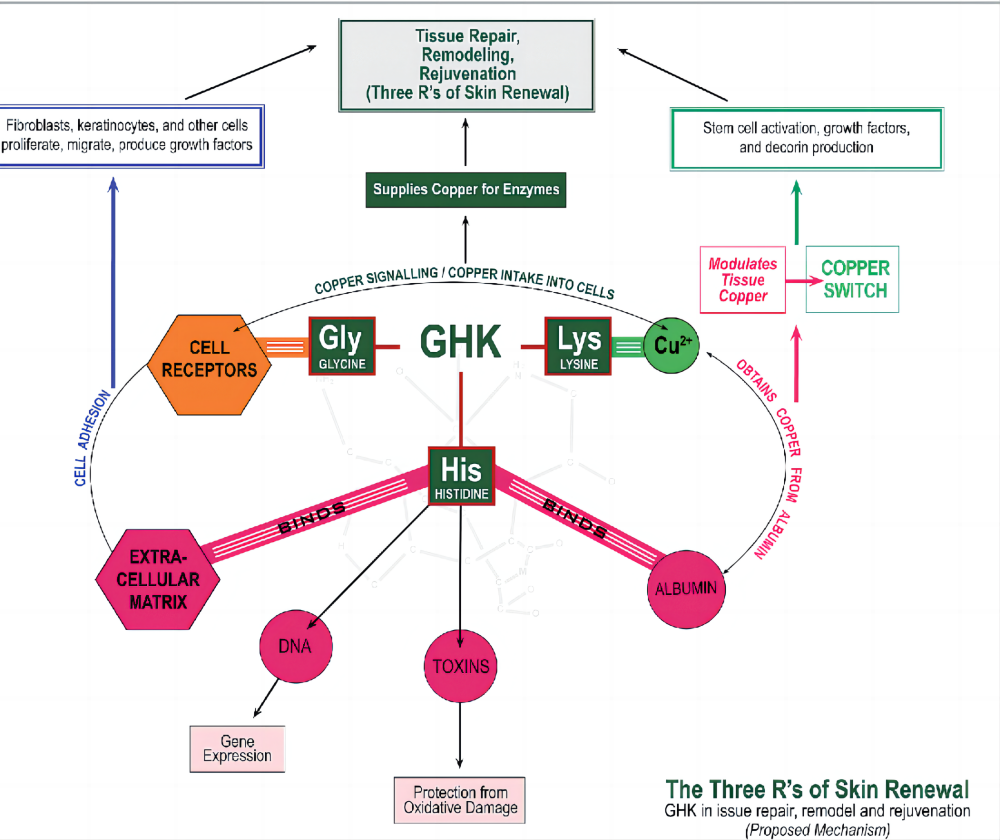1. Copper Tripeptide-1 Overview
Copper Tripeptide-1 is a compound of Glycyl Histidyl Lysine Tripeptide combined with copper ions, which is a small molecule copper peptide complex naturally occurring in human plasma, urine, saliva and cerebrospinal fluid. Copper Tripeptide-1 is a member of the peptide family and one of the few peptides present in the human body, with mild anti-wrinkle and firming effects, it is currently the better anti-aging ingredients.

| Product Name | CAS No. | INCI Name |
| Copper Tripeptide-1 | 89030-95-5 | COPPER TRIPEPTIDE-1 |
| Molecular Formula | Molecular Weight | Molecular Structure |
| C14H22N6O4Cu | 401.91 |  |
2. Background of Copper Tripeptide-1
Copper Tripeptide-1 was first isolated from blood plasma in 1973 by Dr. Loren Pickart and others in the United States. Although copper-binding tripeptide-1 was initially discovered as an active ingredient capable of producing new proteins in aging liver cells, subsequent research soon shifted the focus to its effects on wound healing and skin tissue remodeling. As the originator of cosmetic peptides, Copper Tripeptide-1 have a long history of use in cosmetics. As early as 1991, the U.S. biotechnology company ProCyte Corporation has already obtained the patent of Copper Tripeptide-1, and formally established the NEOVA brand in 1999, dedicated to the blue copper peptide applied to human tissue repair, wrinkle reduction, anti-aging and hair growth treatment.
In recent years, Copper Tripeptide-1 has become one of the most popular high-end cosmetic ingredients on the market due to its small molecular size, easy absorption, high activity and non-irritating properties. As a rising star among functional ingredients, the unique blue-violet crystal appearance of Copper Tripeptide-1 makes it stand out.
3. Manufacture process of Copper Tripeptide-1
At present, peptide synthesis technology has evolved to the third generation. The third generation technology refers to the new generation of fermentation technology developed by synthetic biology, and the enzyme catalytic technology which is regarded as the most promising technology for the sustainable development of modern industry. Enzyme is an important catalyst in living organisms, which is an organic substance with catalytic effect produced by living cells. Synthetic biology technology can use enzyme as a biocatalyst to realize the biological preparation of compounds, which has the characteristics of mild process conditions and strong specificity. The third generation technology not only reduces the waste of non-renewable resources, but also well reduces the impact of pollution on the surrounding environment. Under the premise of pure green technology, the production cost is reduced to the lowest in history, and the scale of production is maximized.
4. Technical Data Sheet of Copper Tripeptide-1
| Items | Specification |
| Purity | ≥99% |
| HPLC identification | Consistent with the reference substance main peak retention time |
| Acetic acid content | ≤15.0% |
| Copper content | 10.0%~16.0% |
| GHK content | 60.0~80.0% |
| Organoleptic Tests | |
| Appearance | Blue to purple powder |
| Physical Characteristics | |
| Moisture | ≤8.0% |
| pH value (1% water solution) | 6.0~8.0 |
| Solubility | ≥100mg/ml (water) |
| Microbiological Tests | |
| Total of bacteria | ≤1000cfu/g |
| Yeast & mold | ≤100cfu/g |
5. Copper Tripeptide-1 Mechanism
5.Copper Tripeptide-1 can effectively stimulate the synthesis of key skin proteins such as collagen and elastin in fibroblasts, and promote the production and accumulation of glycosaminoglycans (GAGs) and small-molecule proteoglycans (PGs), which can achieve the effect of repairing and remodeling the structure of aging skin. Copper Tripeptide-1 not only stimulates the activity of different matrix metalloproteinases, but also stimulates the activity of anti-proteases (which promote the extracellular breakdown of matrix proteins). By regulating both metalloproteinases and antiproteases, Copper Tripeptide-1 helps the skin maintain a balance between matrix breakdown and synthesis, promoting skin cell regeneration and improving its aged appearance.

6. Copper Tripeptide-1Benefits
- Anti-aging
Copper Tripeptide-1effectively stimulates the synthesis of key skin proteins such as collagen and elastin in fibroblasts; and promotes the production and accumulation of specific glucosaminoglycans (GAGs) and small-molecule proteoglycans.Copper Tripeptide-1 achieves the effect of repairing and remodeling the structure of aging skin.
Copper Tripeptide-1 stimulates not only the activity of different matrix metalloproteinases, but also antiproteases (these enzymes promote the breakdown of extracellular matrix proteins). By regulating metalloproteinases and their inhibitors (antiproteases), Copper Tripeptide-1 maintains the balance between matrix breakdown and synthesis, supporting skin regeneration and improving its aged appearance.
- Skin repair
GHK sequences are present in the α2(I) chain of type I collagen in the organism, as well as in the glycoprotein SPARC, which is produced by endothelial cells at the site of wounds, and will be released at the site of wounds when protein hydrolases are activated by damage and breakdown of tissues, and is an early signal for tissue repair.
Copper ions are very important components in many enzymatic reactions, and due to its high affinity for copper ions, GHK can access copper ions bound to other molecules (e.g., albumin) and act as a local delivery vehicle for copper ions at the site of injury.
The support of Copper Tripeptide-1 to fibroblasts illustrates its ability to promote wound healing. As key cells in the skin regeneration process, fibroblasts not only synthesize structural components of the dermal matrix, but also produce a variety of growth factors (e.g., fibroblast growth factor bFGF, vascular endothelial growth factor VGF) required for skin repair.
Epidermal stem cells are slow-cycling cells located in the basal layer that maintain an undifferentiated state throughout the life cycle of the organism. In case of injury, epidermal stem cells can differentiate into various cells in the skin, including fibroblasts, melanocytes, and endothelial cells, which have the potential to repair and regenerate various tissues. The loss of proliferative potential of epidermal stem cells is associated with their flattened shape and reduced expression of integrins and p63 protein. The use of Copper Tripeptide-1 has been shown to significantly increase the expression of integrins and p63 proteins, to make stem cells more cuboidal in shape, and to restore their proliferative potential, making them a powerful participant in the process of tissue repair.
- Anti-oxidation, anti-inflammation
The antioxidant effects of GHK have been demonstrated in vitro and in studies targeting wound healing in animals. These include inhibition of reactive carbonyl species (RCS) formation, purification of toxic products of lipid peroxidation reactions (e.g., acrolein), protection of keratinocytes from lethal UVB radiation, and prevention of liver damage by dichloromethane free radicals.
Immune cells use reactive oxygen species (ROS) and other strong oxidants (e.g., hypochlorite, peroxynitrite) to fight bacteria, so inflammation is always accompanied by increased oxidative damage. According to relevant studies, Copper Tripeptide-1 can achieve anti-inflammatory effects by decreasing the levels of inflammatory cytokines (e.g. TGF-β and TNF-α) in the acute phase.
The biological significance of Copper Tripeptide-1 is primarily based on its unique relationship with copper, a copper ion used by more than a dozen enzymes, such as the antioxidant enzyme SOD (superoxide dismutase). Thus providing copper to tissues can improve many aspects of tissue metabolism, including antioxidant defense as well as inhibiting inflammation.
7. Plamed Copper Tripeptide-1 Characteristic
- Purity is up to 99%.
- Easy to dissolve and good stability.
- We strictly control the complexation process between copper ions and GHK. The copper ions in Plamed Tripeptide-1 form a stable penta-coordinated complex with GHK, avoiding skin irritation caused by free copper.
8. Copper Tripeptide-1 Application & Reference Dosage
Application & Reference Dosage
| Application Product | Reference Dosage |
| Facial cleanser, toner, essence, lotion, cream, gel, eye cream, aftershave, etc. | 0.05% ~ 0.2% |
- It is added in the final stage of cosmetics.
- pH preferably around 7.
pH affects the complexation of GHK with copper. In solution, when the pH is lower than 4.0, hydrogen ions in solution will destroy the complexation structure of GHK with copper, and the metal-ligand charge transfer (MLCT) phenomenon will no longer occur, and the blue color will disappear. When the pH is greater than 8.0, copper ions in Copper Tripeptide-1 easily react with hydroxide to form insoluble compounds such as copper hydroxide. - Temperature <40℃
Incompatibility of Copper Tripeptide-1:
- Retinol (and its derivatives): non-stackable, when Copper Tripeptide-1meets VA Alcohol, it will turn into a new cloudy and thick green object; VA Alcohol will be converted to generate VA Acid in the process of its action, VA Acid is more acidic, and after reacting with Copper Tripeptide-1, it will lead to inactivation of Copper Tripeptide-1’s Copper Ion.
- Acids (Fruit, Lactic, Salicylic, Amygdalus, Lactobionic, Azelaic, Malic): not stackable, Copper Tripeptide-1 is unstable in acidic environments and will render it ineffective.
- Antioxidants such as carnosine and ergothioneine: not stackable. The imidazole ring in the molecular structure of carnosine and ergothioneine can easily complex metal ions, and when paired with Copper Tripeptide-1, they will compete for copper ions, and the interaction between the raw materials will lead to double failure and discoloration.
- Complexing agent (disodium EDTA, carbomer): Complexing agent will rob copper ions and destroy the structure of Copper Tripeptide-1, leading to its inactivity and producing discoloration at the same time.
- Copper Tripeptide-1 copper ions and GHK ligand complex structure is susceptible to pH, reducing agents and chelating agents, should be avoided and plant extracts, active enzyme extracts and other raw materials with complex composition of the compound use of Copper Tripeptide-1 itself has a multi-functional, can stimulate the synthesis of collagen, elastin and glycosaminoglycan, and promote the proliferation of fibroblasts, keratinocytes and other cells, and can also stimulate the synthesis of collagen, elastin and glycosaminoglycan. Copper Tripeptide-1 has multiple effects, it can stimulate the synthesis of collagen, elastin and glycosaminoglycan, promote the proliferation of fibroblasts and keratinocytes, and inhibit the expression of inflammatory factors.
9. Copper Tripeptide-1 Safety
- International Cosmetic Raw Material Standard Chinese Name Directory (2015 edition) has included Copper Tripeptide-1.
- Copper in GHK-Cu exists in the form of complexes, which are not irritating to the skin and do not show cytotoxicity in the experimental concentration range. However, free copper ions exhibited cytotoxicity and risk of skin irritation.
10. Copper Tripeptide-1 application cases in major cosmetic brands
| Country | Brand | Product |
| France | MEDSPA | Lifting & Firming Serum |
| South Korea | The history of Whoo | Bichup First Moisture Anti-Aging Essence |
| LANEIGE | Time Freeze Eye Serum EX | |
| Germany | DERMAFIRM | Ultra Soothing Formula R4 |
| USA | Olecule Skin Bionics | Copper Peptide Rejuve Serum |
| Canada | The Ordinary | “Buffet” • Copper Peptides 1% Multi-Technoloay Peptide Serum |
11. What is a simple way to identify Copper Tripeptide-1?
Copper Tripeptide-1 is a stable complex formed by GHK tripeptide and copper ions, which is easily soluble in water. The blue copper peptide solution does not leave any color residue when applied to the skin, while the so-called “Copper Tripeptide-1” with added color is a mixture of GHK, copper salts, and color, which leaves a color residue when applied.
12. Packing and Storage
Package: 1kg/bag.
Storage: Preserve in tight containers. Store at a temperature 2 to 8℃
13. Related Reading
1. Copper Peptide Benefits for Skincare
Plamed focuses on natural cosmetic ingredients for more than 10 years. We have founded four subsidiary companies, which respectively develops different kinds of cosmetic raw material. Plamed is a company whose CEO is designated as the first secretary general of Shaanxi Plant Extraction Association.
As a professional Copper Tripeptide-1 manufacturer, Plamed have been constantly upgrading the production process. We firmly believe that goodCopper Tripeptide-1 and good Copper Tripeptide-1 price will help customers make good terminal products and help customers win a lasting and broad market.













